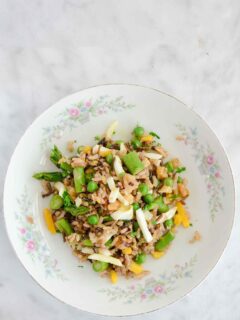I like to order my seeds from a few different sources, one of them is JUNG SEEDS. They sent out their newsletter last weekend and an article touched on the Hot Weather and its effects on our garden. Since my garden really took a beating during the heat wave, I found the article really informative, so I thought I would share.
Tomatoes are the most widely planted garden crop. An abundance of blossoms on tomatoes doesn’t always result in a bumper crop. Temperatures above 85 degrees F. can affect pollination and fruit set. Studies have shown that daytime temperatures in excess of 95 degrees and night time temps of over 75 degrees may cause flowers to fall off. Temperatures over 100 degrees can make the plant go into survival mode, causing red pigments in tomatoes to stop forming, while the yellow and orange ones continue. If this is the case, it’s best to pick the tomatoes when they begin to turn red and allow them to ripen indoors at cooler temperatures.

It takes about 5 weeks for a tomato flower to become a ripe fruit – the first 3 weeks to get to full size and the last 2 weeks to fully ripen. Temperatures above 90 degrees will slow fruit growth and ripening, so if you’ve planted a large-fruited variety, you probably won’t harvest the big tomatoes you are expecting. This is not the fault of the variety – it is a result of the heat. Once the excessive heat is over, it will most likely take five more weeks to begin harvesting tomatoes again. Tomatoes that have developed to full size in spite of dry weather may suddenly grow again if watered or rained on, and the result may be split fruit.
Cucumbers are also often affected by multiple days of excessive heat, dropping their blossoms and developing fruit may become misshapen with a bulbous end that’s somewhat gourd-like. Developing fruits of eggplant and cucumbers experiencing stresses such as high temperatures, dryness, low fertility or foliage disease may acquire a bitterness to their flavor. For cucumbers, the longer ‘burpless’ types are usually not affected with bitter flavor as severely as pickling types. In most cases, cutting off the stem-end and removing the skin of bitter cucumbers will remove much of the bitterness.

Successive 90+ degree days may cause other crops such as squash, peppers, melons, pumpkins and beans to shed their blossoms and go into a temporary ‘shut-down’ mode to conserve their resources.

Cool-season crops such as broccoli, cabbage, lettuce and spinach will bolt. Blossom end rot is also common during hot weather and most prevalent in tomatoes, peppers, and squash.
Hot, dry weather often results in an invasion of spider mites on plants. These insects will cause the leaves to look like they are stressed. To check for spider mites, hold a sheet of white paper under the leaves and tap the plant. The specks on the paper may start to move. If you run your hand firmly over the white paper, streaks will appear on the paper. Insecticidal soap is one of the best controls for spider mites.
Just so you know that all is not gloom and doom, a positive result of hot, dry conditions is a reduction in fungal diseases such as powdery mildew and blight.
While there isn’t much we can do about the hot temperatures, you can still save much of your garden if you can keep it sufficiently watered until saving rains come.
I diligently watered during the heat wave, while everything is green, the produce really took a beating. Hopefully the heat wave headed here this week, will be short.









Reblogged this on The Salem Garden and commented:
I’ve seen lots of questions and comments about the hot weather’s effect on our gardens in the past few days so I’d like to share this great post by Amy at A Healthy Life for Me. There’s lots of good explanation and answers to questions. I hope it’s helpful to all of my friends who are dealing with heat and drought right now.
Here in Iowa we’ve been experiencing nearly a month of 90+ degree days, and I’ve got several of the problems you mentioned, including my squash plants aborting blossoms, and some blossom end rot on a few tomatoes. I’ve noticed that since the hot weather set in, my tomatoes haven’t been setting new fruit- now I’ve read your post, I have a good idea why. I’m sad that because of this drought, my first garden hasn’t been much of a success, and have to keep reminding myself that it’s not really my fault. This was very informative, and you just got yourself another follower :]
Glad it helped. It’s hard to keep enthusiastic when all your hard work doesn’t pay off right away. We have had a week long break from the heat and some much needed rain. I pulled off a few tomatoes, and the plants seemed to perk up a bit, so I am feeling a renewed pleasure in the garden. I planted my fall seeds, so hopefully we will all be rewarded with some kinder fall weather and bigger produce before we head into winter. Thanks for following!!
Although we frequently get temperatures over 100 degrees here in the Central Valley of California, I’ve never had a problem with slowed production of tomatoes. My sister who lives in Las Vegas, NV, however, can’t even grown tomatoes because their temps are even higher on a regular basis.
Between trying to keep the chickens comfortable and the garden watered, I just don’t know how you do it! Its a full time job fighting this heat. URGHH! I finally pulled about 6 tomatoes on Sunday, so that pacified me a bit.
Really helpful post thanks x whilst I doubt I’ll have to manage the high temperatures here it’s so useful to find out the effects on plants and how others are coping with different gardening climates!
Same here, when you write about how the rain is making it tough for you, I enjoy hearing about how your dealing with it. I like your idea of going shopping! 🙂